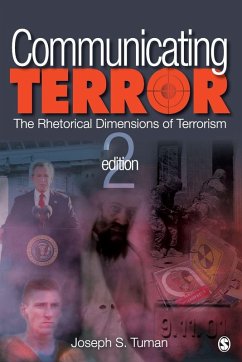- Broschiertes Buch
- Merkliste
- Auf die Merkliste
- Bewerten Bewerten
- Teilen
- Produkt teilen
- Produkterinnerung
- Produkterinnerung
Concise yet comprehensive, this up-to-date text examines how acts of "terrorism" create rhetorical acts: What messages, persuasive meanings, symbols, do acts of terrorism generate and communicate to the world at large? These rhetorical components include definitions and labels, symbolism in terrorism, public oratory about terrorism, and the relationship between terror and media. This unique communication perspective (vs. political scienceiminal justice approach) shows how the rhetoric of terrorism is truly a war of words, symbols, and meanings.
Andere Kunden interessierten sich auch für
![Communicating Effectively Communicating Effectively]() Saundra HybelsCommunicating Effectively149,99 €
Saundra HybelsCommunicating Effectively149,99 €![Communicating Professions via Blog. An Applied Linguistics Approach Communicating Professions via Blog. An Applied Linguistics Approach]() Roxanne Barbara DoerrCommunicating Professions via Blog. An Applied Linguistics Approach47,95 €
Roxanne Barbara DoerrCommunicating Professions via Blog. An Applied Linguistics Approach47,95 €![Towards Success in Communicating and Teaching Internationally Towards Success in Communicating and Teaching Internationally]() Marijana ProdanovicTowards Success in Communicating and Teaching Internationally30,99 €
Marijana ProdanovicTowards Success in Communicating and Teaching Internationally30,99 €![The Social Psychology of English as a Global Language The Social Psychology of English as a Global Language]() Robert M. McKenzieThe Social Psychology of English as a Global Language74,99 €
Robert M. McKenzieThe Social Psychology of English as a Global Language74,99 €![A Typology of Verbal Borrowings A Typology of Verbal Borrowings]() Jan WohlgemuthA Typology of Verbal Borrowings145,99 €
Jan WohlgemuthA Typology of Verbal Borrowings145,99 €![Variation in Linguistic Systems Variation in Linguistic Systems]() James A. WalkerVariation in Linguistic Systems221,99 €
James A. WalkerVariation in Linguistic Systems221,99 €![Key Ideas in Linguistics and the Philosophy of Language Key Ideas in Linguistics and the Philosophy of Language]() Siobhan Chapman / Christopher RoutledgeKey Ideas in Linguistics and the Philosophy of Language130,99 €
Siobhan Chapman / Christopher RoutledgeKey Ideas in Linguistics and the Philosophy of Language130,99 €-
-
-
Concise yet comprehensive, this up-to-date text examines how acts of "terrorism" create rhetorical acts: What messages, persuasive meanings, symbols, do acts of terrorism generate and communicate to the world at large? These rhetorical components include definitions and labels, symbolism in terrorism, public oratory about terrorism, and the relationship between terror and media. This unique communication perspective (vs. political scienceiminal justice approach) shows how the rhetoric of terrorism is truly a war of words, symbols, and meanings.
Hinweis: Dieser Artikel kann nur an eine deutsche Lieferadresse ausgeliefert werden.
Hinweis: Dieser Artikel kann nur an eine deutsche Lieferadresse ausgeliefert werden.
Produktdetails
- Produktdetails
- Verlag: Sage Publications, Inc
- Artikelnr. des Verlages: B73243P
- 2. Auflage
- Seitenzahl: 242
- Erscheinungstermin: 15. Oktober 2009
- Englisch
- Abmessung: 229mm x 152mm x 13mm
- Gewicht: 357g
- ISBN-13: 9781412973243
- ISBN-10: 1412973244
- Artikelnr.: 26840963
- Herstellerkennzeichnung
- Books on Demand GmbH
- In de Tarpen 42
- 22848 Norderstedt
- info@bod.de
- 040 53433511
- Verlag: Sage Publications, Inc
- Artikelnr. des Verlages: B73243P
- 2. Auflage
- Seitenzahl: 242
- Erscheinungstermin: 15. Oktober 2009
- Englisch
- Abmessung: 229mm x 152mm x 13mm
- Gewicht: 357g
- ISBN-13: 9781412973243
- ISBN-10: 1412973244
- Artikelnr.: 26840963
- Herstellerkennzeichnung
- Books on Demand GmbH
- In de Tarpen 42
- 22848 Norderstedt
- info@bod.de
- 040 53433511
Joseph S. Tuman (J.D., University of California, Berkeley; B.A., political science, University of California, Berkeley) is Professor of Political and Legal Communications at San Francisco State University, where he regularly teaches upper-division courses in rhetoric and terrorism, political and legal communication, argumentation & advocacy, and technology and human communication. A past recipient of the Jacobus tenBroek Society Award for Teaching Excellence, Professor Tuman has also taught at the University of California, St. Mary's College, the New School for Social esearch, and Paris II, the top law school in France. He is the author of Political Communication in American Campaigns(SAGE, ©2008) and the co-author of numerous books, including Freedom of Speech in the Marketplace of Ideas and of The Bedford/St. Martin¿s Guide to Public Speaking; he has also been the journal editor of Contemporary Argumentation & Debate: The Journal of the Cross Examination Debate Association. His work has been featured in news publications such as the New York Times, Los Angeles Times and the San Francisco Chronicle, and he has served as a network analyst for news programs on ABC, NBC, CNN and CNN International, FOX and the BBC. He currently appears as a regular political commentator for CBS in the western United States.
Introduction
1. The Struggle to Define Terrorism
Defining Terrorism
Attempts to Synthesize a Consensus Definition
Summary
Notes
2. Terrorism as a Communication Process With Rhetorical Dimensions
Terrorism as a Communication Process
Terrorism and Rhetoric
Summary
Notes
3. Labeling and Defining Terrorism as Rhetoric
Definitions and Labels
Reconsidering the Definition of Terrorism
Summary
Notes
4. Symbols, Symbolism, and Terrorism: Means and Implements
Symbols, Symbolism, and Violence/Destruction
Symbolism in the Implements and Tools of Terrorism
Summary
Notes
5. Symbolism in the Targets of Terrorism
Temporal Targets for Terrorism
Symbolism in the Chechen Terrorist Attack on a Moscow Theater
Symbolism, the World Trade Center, and the Pentagon
Summary
Notes
6. Methods for Studying Public Oratory About Terrorism
A Method of Rhetoric for Public Oratory
Summary
Notes
7. Case Studies for Public Oratory About Terrorism
President Bush's Speech to the Nation Immediately After the Attacks of 9/11
President Bush's Speech to the Congress, the Nation, and the World on
September 20, 2001
Speech by Osama bin Laden, Dated 11/1/2004: Just Before the 2004 General
Election in the United States
Summary
Notes
8. Theories of Mass Media for Terrorism
Understanding Mass Media
Media-Centered Criticism
Summary
Notes
9. Mass-Mediated Images and Construction of Terrorism
Terrorism From Above and Mass Media
Terrorism From Below and Mass Media
Agenda Setting and the Framing of Terrorism in News Media
Terrorism and New Media
Terrorism and Paid Media
Summary
Notes
Index
About the Author
1. The Struggle to Define Terrorism
Defining Terrorism
Attempts to Synthesize a Consensus Definition
Summary
Notes
2. Terrorism as a Communication Process With Rhetorical Dimensions
Terrorism as a Communication Process
Terrorism and Rhetoric
Summary
Notes
3. Labeling and Defining Terrorism as Rhetoric
Definitions and Labels
Reconsidering the Definition of Terrorism
Summary
Notes
4. Symbols, Symbolism, and Terrorism: Means and Implements
Symbols, Symbolism, and Violence/Destruction
Symbolism in the Implements and Tools of Terrorism
Summary
Notes
5. Symbolism in the Targets of Terrorism
Temporal Targets for Terrorism
Symbolism in the Chechen Terrorist Attack on a Moscow Theater
Symbolism, the World Trade Center, and the Pentagon
Summary
Notes
6. Methods for Studying Public Oratory About Terrorism
A Method of Rhetoric for Public Oratory
Summary
Notes
7. Case Studies for Public Oratory About Terrorism
President Bush's Speech to the Nation Immediately After the Attacks of 9/11
President Bush's Speech to the Congress, the Nation, and the World on
September 20, 2001
Speech by Osama bin Laden, Dated 11/1/2004: Just Before the 2004 General
Election in the United States
Summary
Notes
8. Theories of Mass Media for Terrorism
Understanding Mass Media
Media-Centered Criticism
Summary
Notes
9. Mass-Mediated Images and Construction of Terrorism
Terrorism From Above and Mass Media
Terrorism From Below and Mass Media
Agenda Setting and the Framing of Terrorism in News Media
Terrorism and New Media
Terrorism and Paid Media
Summary
Notes
Index
About the Author
Introduction
1. The Struggle to Define Terrorism
Defining Terrorism
Attempts to Synthesize a Consensus Definition
Summary
Notes
2. Terrorism as a Communication Process With Rhetorical Dimensions
Terrorism as a Communication Process
Terrorism and Rhetoric
Summary
Notes
3. Labeling and Defining Terrorism as Rhetoric
Definitions and Labels
Reconsidering the Definition of Terrorism
Summary
Notes
4. Symbols, Symbolism, and Terrorism: Means and Implements
Symbols, Symbolism, and Violence/Destruction
Symbolism in the Implements and Tools of Terrorism
Summary
Notes
5. Symbolism in the Targets of Terrorism
Temporal Targets for Terrorism
Symbolism in the Chechen Terrorist Attack on a Moscow Theater
Symbolism, the World Trade Center, and the Pentagon
Summary
Notes
6. Methods for Studying Public Oratory About Terrorism
A Method of Rhetoric for Public Oratory
Summary
Notes
7. Case Studies for Public Oratory About Terrorism
President Bush's Speech to the Nation Immediately After the Attacks of 9/11
President Bush's Speech to the Congress, the Nation, and the World on
September 20, 2001
Speech by Osama bin Laden, Dated 11/1/2004: Just Before the 2004 General
Election in the United States
Summary
Notes
8. Theories of Mass Media for Terrorism
Understanding Mass Media
Media-Centered Criticism
Summary
Notes
9. Mass-Mediated Images and Construction of Terrorism
Terrorism From Above and Mass Media
Terrorism From Below and Mass Media
Agenda Setting and the Framing of Terrorism in News Media
Terrorism and New Media
Terrorism and Paid Media
Summary
Notes
Index
About the Author
1. The Struggle to Define Terrorism
Defining Terrorism
Attempts to Synthesize a Consensus Definition
Summary
Notes
2. Terrorism as a Communication Process With Rhetorical Dimensions
Terrorism as a Communication Process
Terrorism and Rhetoric
Summary
Notes
3. Labeling and Defining Terrorism as Rhetoric
Definitions and Labels
Reconsidering the Definition of Terrorism
Summary
Notes
4. Symbols, Symbolism, and Terrorism: Means and Implements
Symbols, Symbolism, and Violence/Destruction
Symbolism in the Implements and Tools of Terrorism
Summary
Notes
5. Symbolism in the Targets of Terrorism
Temporal Targets for Terrorism
Symbolism in the Chechen Terrorist Attack on a Moscow Theater
Symbolism, the World Trade Center, and the Pentagon
Summary
Notes
6. Methods for Studying Public Oratory About Terrorism
A Method of Rhetoric for Public Oratory
Summary
Notes
7. Case Studies for Public Oratory About Terrorism
President Bush's Speech to the Nation Immediately After the Attacks of 9/11
President Bush's Speech to the Congress, the Nation, and the World on
September 20, 2001
Speech by Osama bin Laden, Dated 11/1/2004: Just Before the 2004 General
Election in the United States
Summary
Notes
8. Theories of Mass Media for Terrorism
Understanding Mass Media
Media-Centered Criticism
Summary
Notes
9. Mass-Mediated Images and Construction of Terrorism
Terrorism From Above and Mass Media
Terrorism From Below and Mass Media
Agenda Setting and the Framing of Terrorism in News Media
Terrorism and New Media
Terrorism and Paid Media
Summary
Notes
Index
About the Author








